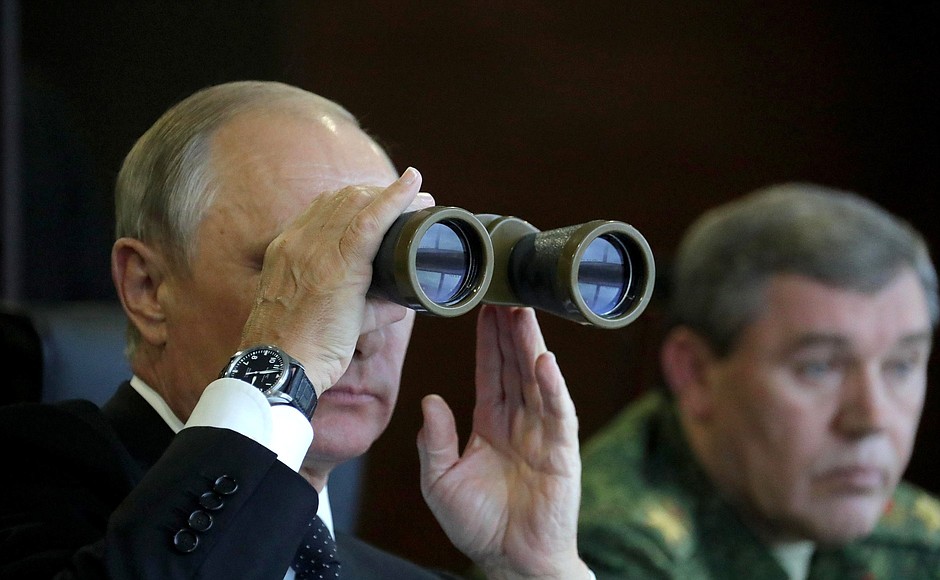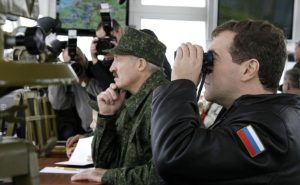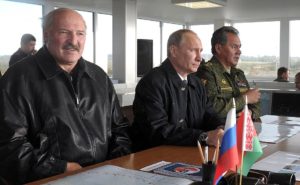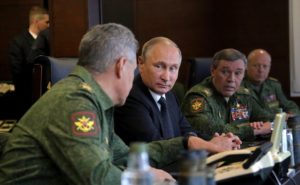 Photo Credit: www.kremlin.ru
Photo Credit: www.kremlin.ru
Under the Cover of Zapad, Putin and Lukashenko Drift Further Apart
After much anticipation and dread by the West, Russia and Belarus’ Zapad-2017 military exercises have come to an end without major incident. So far, Zapad has not turned out to be as dramatic as many have feared. But the wargames have offered a key window into tense relations between Russia and one of its closest post-Soviet partners. In particular, it raises further questions about the eroding relationship between Russian President Vladimir Putin and Belarusian President Alexander Lukashenko, reinforcing those I raised before the exercises began.
The Zapad exercises occur every four years, with the previous exercise occurring in 2013. During the height of those wargames, Lukashenko was highly visible with Putin, with the two leaders observing the climax of the wargames together. Lukashenko was also present for the Zapad-2009 exercises, similarly sitting in the reviewing stand with former-President and now Prime Minister of Russia Dmitri Medvedev to observe their combined military power.

Belorussian President Alexander Lukashenko with former Russian President Dmitri Medevedev observing Zapad-2009 (Photo Credit: www.kremlin.ru).
The situation has changed drastically since then. The following year after Zapad-2013, Russia would annex Crimea following the departure of the pro-Russian President of Ukraine. Russian interference would soon escalate to support a separatist uprising in Ukraine’s eastern Donbass region as well. This caused a rift to grow between Belarus and Russia, which was only aggravated by a high-profile dispute earlier this year between the two nations centered on the pricing and transit of oil and gas.

Lukashenko also was present with current President of Russia Vladimir Putin to watch the 2013 Zapad exercises (Photo Credit: www.kremlin.ru).
Now there may be signals of the state of Russo-Belarusian relations following these disputes in the handling of the Zapad exercises by the two leaders. Putin arrived in the Leningrad Military District to view combat drills on September 18th. Flanked by Russian military officers and defense officials, one individual who was conspicuously absent was Lukashenko. The press release regarding Putin and his visit to the exercise from the Kremlin fails to mention Lukashenko at all, despite the involvement of Belarusian troops.— This appears to be the case with Russian government owned TASS and the pro-Kremlin media outlets RT and Sputnik as well.

Putin at the Zapad 2017 drills on September 18th— without Lukashenko (Photo Credit: www.kremlin.ru).
Lukashenko’s office has also been relatively quiet on his role in the exercises. It was only on the 15th—a day after the exercises had begun—that his press secretary confirmed he would even be observing them at some point. It then took until the 18th—the day of Putin’s observation of the drills—for Lukashenko’s office to issue another press release confirming when and where he would observe. The content of that release was telling: Lukashenko wouldn’t be observing the wargames until the 20th, the final day of the exercises—and he would be doing so without Putin.
The tone of the Belarusian state media and government on Lukashenko’s participation in the wargames has been defensive and even passive-aggressive. Allegedly, initial plans for the wargames had Lukashenko travelling to Russia to observe its active phase. But Lukashenko’s office claims no official invitation was sent by the Russian government. Likewise, his office also claims that an invitation was sent to Putin for him to come and observe the exercises in Belarus, but as of the 15th, Lukashenko’s staff claimed no response had been received from the Russians. Lukashenko himself quickly backtracked on the 20th however, claiming that the two leaders had, in fact, decided ahead of time they would observe the wargames from within their own countries.
These breaks in precedent are telling. For the past eight years, each Zapad exercise featured both the Russian and Belarusian Presidents watching the climax of the drills together in Belarus. Though neither country has been openly clashing with each other in the news—as Belarus did with Russia during the peak of its energy dispute—the separation still speaks volumes, and raises yet more questions about the health of the Russo-Belarusian relationship. The fact that Lukashenko also felt it necessary to speak up and clarify his and Putin’s separation during the wargames and try to project some sense of normalcy is also illuminating.
All of this reinforces what might be the most valuable lesson to come out of Zapad-2017: Putin and Lukashenko’s partnership is still on shaky ground following the Spring energy disputes, and may only get weaker. This relationship needs to be watched carefully. If the West fails to pay close attention to Putin’s relationship with Lukashenko going forward, in the context of increased Russian tensions with NATO, it risks being taken by surprise as it was in Ukraine. An overt and forceful rift between Russia and a key strategic partner, on the frontline of military tension between Russia and NATO, is something the United States cannot afford to be unprepared for.





